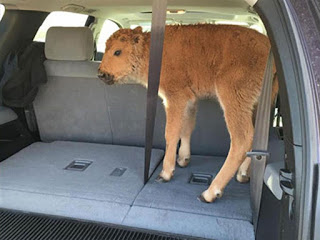Search Results for: wildlife
Another Industry’s Time Has Come
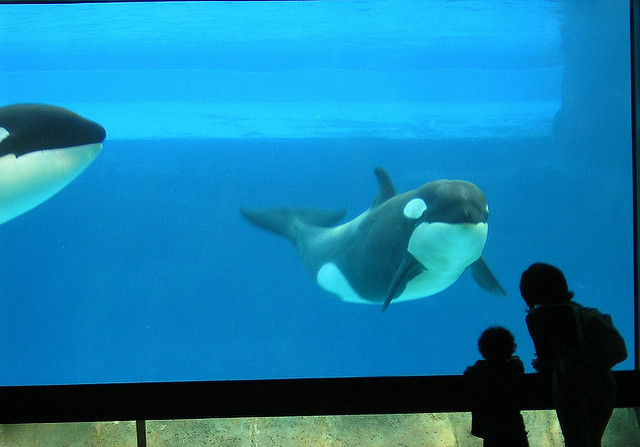 Everyone who cares about animals was disappointed to see the charges against Marineland dropped last week. Later, we were alarmed to hear about yet another round of complaints about Papanack Zoo stemming from shocking undercover footage of the conditions there.
Everyone who cares about animals was disappointed to see the charges against Marineland dropped last week. Later, we were alarmed to hear about yet another round of complaints about Papanack Zoo stemming from shocking undercover footage of the conditions there.
Papanack is closer to home. In fact, it is just outside of the jurisdiction of the OHS in an area long-served by the OSPCA. Of course, many of the zoo’s visitors are from Ottawa, and we have received many dozen complaints about it over my 17 years at the OHS; all were passed on to the OSPCA when received.
Across the country most complaints about these profit-making operations are based on the kind of limited protections available to animals under current legislation, such as access to food, water, shelter, etc. But here’s the thing: these issues are beside the point. Let’s move beyond whether animals in zoos and aquaria are cared for to a minimally acceptable standard and agree that their time is over. Like their travelling cousins, the circuses, the time of zoos and aquaria has passed. We know better now. Animals need more than food and water. They need to be with their own species. They need to live in social groups. They need to express natural behaviours.
That is why we are supporting the call from our national partner, the Canadian Federation of Humane Societies, for the formation of a federal/provincial task force to study the high number of animal deaths in Canada’s zoos, aquaria and other captive wildlife facilities and to determine a new animal protection framework for the industry. We hope that this process will result in real change. And, I hope, one day the end to these inherently inhumane businesses.
Bruce Roney
Executive Director
Rhinos, Fundraising, a Little Thought and a Little Research
My Facebook feed declared last night that the Western Black Rhinoceros had been declared officially extinct. I was sad. I have never seen one and now never would. The world — my world — felt diminished without this creature in it. Because of the prevalence of false news on social media, I decided to make sure the story was true. Snopes, my go to source for reality, confirmed the story. The demise of Western Black Rhino has indeed happened. In 2006. Okay, that doesn’t make it any better. But I am glad I took the time to check the story and didn’t share it.
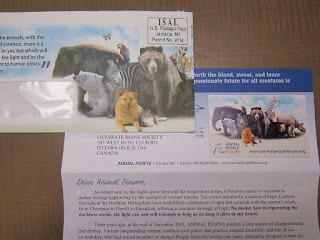
Letter from the Animal People Forum.
Similarly, yesterday, I received a letter from an organization called Animal People Forum. The postmark was Jamaica, New York, though with a mailing address in the state of Washington. Overall the piece looked a bit odd. And despite my 17 years in animal welfare, I had never heard of this organization. So, I went to their website. I looks pretty good. But you have to read it carefully. They have four projects. One is called, “Beyond Human: Animals, Aliens and Artificial Intelligence.” Yikes. I’m glad I checked that one out too.
This all made me wonder how many letters hit our supporters’ mailboxes, and whether people check out what they receive. In my experience, people who care about animals are a very kind bunch. They want to help. Sadly, this can be taken advantage of. And there are groups that range from misleading and dubious to outright frauds ready to take advantage.
I would never presume to tell anyone the causes they should support but I hope and pray that people ensure that they are really supporting the issue they intend. It only takes little thought and a little research.
First, what are the issues you care about? Mainly domestic pets? Wildlife? Are you mainly concerned about local issues? National? International? All of the above? Do you want to support actual care for animals or do you think that awareness and advocacy are really going to affect change? Having considered these questions before that very emotional appeal hits your mailbox can help you to make sure your hard-earned cash does what you want it to.
The second consideration is whether the organization asking you for cash actually does what it says — or implies. A quick review of their website is sometimes all you need to do. What does this organization actually do? Be careful here, I have a seen some misleading practices. A few sites show animals for adoption, but none of the animals are actually in the care of that organization, just adoptable animals pulled from other websites. An organization may highlight an important issue, but it’s not clear what they are doing about it. I am very concerned about the loss of the Western Black Rhino, but the OHS website does not imply that we did anything to try to prevent it. Beware too of small gestures that are expensive and may not add up to significant change. Sending a staff team to China to adopt a few dogs from the meat markets and fly them back to Canada may raise awareness, and it certainly saves some canine lives, but is supporting the flights the best way to close the markets? Is it where you want to invest your money?
Other places you can check are the Canada Revenue Agency charities listings. Every registered charity in Canada is listed and you can easily find out how they spend their money with a few clicks. And if they are not a registered charity, ask yourself why not?
If it is a humane society asking for your support, are they a member of the Canadian Federation of Humane Societies (CFHS)? Most are. And another few clicks on the CFHS site can tell you.
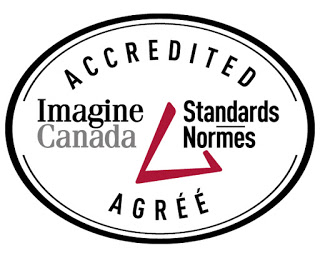
The OHS is one of only two humane societies in Canada to achieve accreditation with Imagine Canada
You can always call us at the OHS too. We won’t provide a recommendation, but we sometimes can provide some basic facts and we will tell you if we work with a particular group. I hope that in the not-too-distant future accreditation of various sorts will help us all in separating the legitimate and effective from the dubious and misleading. That is why the OHS sought and achieved accreditation with Imagine Canada for excellence in board governance, financial accountability, fundraising, staff management, and volunteer involvement last year. We wanted to support this direction among not-for-profits and wanted to assure our community of supporters of our commitment.
Few charities have achieved this, and only one other humane society in Canada, the British Columbia SPCA, has done so to date. I am not suggesting that those that haven’t are not legitimate, but I look forward to a day when you and I can rely on this and other forms of accreditation to assure that our kindness is not exploited.
Until then, you and I can do it ourselves, through a little thought and a little research.
Bruce Roney
Executive Director
Different Cats, Different Solutions
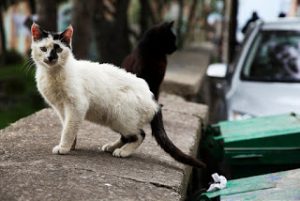
Too many cats will live wretched lives as long as there are too many cats.
As our new Mobile Spay/Neuter Vehicle hits the streets, the prospect for long-term solutions to cat overpopulation and cat welfare are becoming clearer. The thing is, cats in our community live in very different circumstances, there are many reasons for the problems, and all need tailored solutions.
A significant source of overpopulation is feral cats. Feral cats are not stray. They are generally the progeny of stray or roaming cats and have never lived with humans. They are not wildlife, nor are they pets. Their lives are generally nasty, brutish and short. According to the experts, our friends at Alley Cat Allies, adults cannot ever be truly socialized to humans, though their young kittens can be.
Then there are “porch” or “loosely owned” cats. These cats are socialized to humans, though may be very skittish. They have, or had, an owner and are fed and loosely cared for by a neighbourhood. Unfortunately, the neighbourhood’s care rarely extends to veterinary care or sterilization. Therefore, these cats are a significant source of unwanted litters. Those not vaccinated can be a reservoir for contagious feline disease.
It can be hard to identify a skittish stray or porch cat from a true feral cat. But in a shelter, socialized porch or owned cats will generally calm with time. Feral cats do not, and may injure themselves, sometimes severely, trying to escape. Their stress can be so intense that they can die of heart failure in a cage. It is not humane to shelter a severely distressed feral cat.
The issues of each type of cat are very different and require different solutions. Since most feral cats cannot be humanely housed, the standard humane practice is “TNR,” or trap/neuter/release, that is, capture, sterilize and vaccinate, and release them where they were found. Feral cat colonies can be phased out over time through TNR. The OHS assisted volunteers to phase out the famous Parliament Hill colony several years ago through TNR in advance of government intervention that may have seen the entire colony euthanized. The OHS will support other feral colony caretakers under certain conditions through free food and sterilization at our clinic.
Porch cats can and should be socialized and rehomed. If they are rehomed through the OHS, they will leave healthy, vaccinated and sterilized to a good home that is ready and able to care for them. They will no longer contribute to cat overpopulation.
I am feeling very positive and hopeful that our efforts are going to produce very significant results and quickly, changing the world for Ottawa’s cats by resolving the problem identified in the OHS’s new five-year strategic plan, that is, too many cats will live wretched lives as long as there are too many cats.
Bruce Roney
Executive Director
A Tragic Death
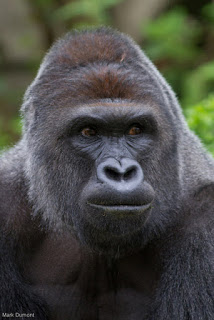 |
| Harambe |
The world has been shocked and horrified by the shooting of Harambe, a 17-year-old silverback gorilla at the Cincinnati Zoo. If you haven’t yet heard the story, a four-year-old boy fell into the gorilla enclosure, and after some tense moments, with the gorilla dragging the boy around the compound and displaying behaviour that some have described as protective, others as dangerously agitated, zoo officials made the decision to shoot Harambe. The child was rescued, relatively unscathed and the gorilla is now dead.
I feel for everyone involved: the child, the distressed mother, the zoo employees called upon to shoot a creature that they had raised from birth — one of the last of his kind. As for Harambe, his death just makes me very, very sad.
I have looked at the footage of the incident, and have thoughts, but given I am in no way an expert, or even slightly conversant in gorilla behaviour, I will not stoke the fire. I will keep my observations to myself.
But here is what I do know: when there is conflict between humans and wild animals, whether they be a gorilla in a zoo, a performing elephant, or a fox living on a piece of land to be developed, the animal almost always loses.
What can you do? You can reject circuses, zoos and aquariums that exploit animals for entertainment. Rather than trapping and relocating wildlife on your property, you can learn to coexist. If we make these changes, maybe one day the animals will stop losing.
Bruce Roney
Executive Director
More than Good Manners
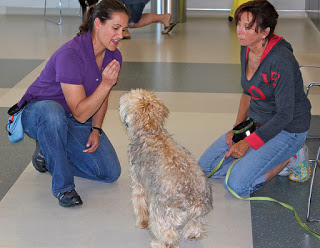 |
| Obedience classes and training have many benefits. |
It’s been quite a few years since I have had a dog in my home life. At the OHS, I am lucky to meet a lot of dogs, but a dog of my own just hasn’t been compatible with my busy work and personal life. As demanding as she can be, my cat Gracie — the Siamese who must be obeyed — doesn’t need as much time as the average dog. So, I have deferred adopting a dog to my retirement.
My last dog was a cocker spaniel. While sweet, and by no means truly badly behaved, Jennie could be a handful. I didn’t take her to obedience classes and I regret this now. Many OHS staff have outstandingly wonderful dogs. I realized over the years that the dogs didn’t come that way. They are great dogs because our staff made an investment of time and effort in training and obedience.
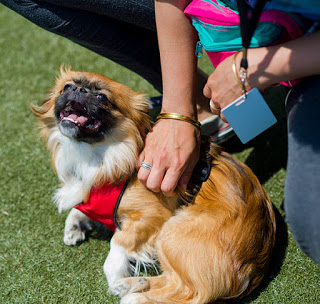 |
| Obedience classes can strengthen the bond between dogs and their owners. |
I have learned my lesson and when I finally bring a dog into my life again, I will spend the time to “create” a wonderful dog with classes. Most people want a dog with good manners and social skills when interacting with people, they want a dog that doesn’t jump up, scare children, or pull on the leash, and can respond to at least simple commands. Classes and training between classes can to do this. Moreover, studies suggest that classes and training enhance the communication and bond between people and their dogs. The time spent has many rewards.
Classes can save a dog’s life. By learning to recall, you can prevent her from being hit by a car or attacked by wildlife or unknown dogs. They can lessen or eliminate those behaviours that can make living with a dog a minor hell: destructiveness, excessive barking, and house soiling for example.
I have learned my lesson; I have been converted. My next dog will be wonderful. She may not be born that way, but that’s okay. I am going to help her become wonderful.
Bruce Roney
Executive Director
Killing with Kindness
The story of two Canadian tourists visiting Yellowstone National Park and “saving” a young bison calf by putting it in the back of their SUV and taking it to a ranger station has gone viral. I hope it becomes a lesson for everyone.
Most of us would feel sick if they killed a healthy young animal by mistake. Here is the thing, people do it all the time. Every spring, all over North America, people pick up juvenile wildlife that don’t need their help. They bring them to a humane society or other authority whose only option is to euthanize the poor creature.
That is what happened to the bison. On May 16, Yellowstone National Park officials announced a baby bison had to be euthanized after a pair of Canadian tourists put the animal in their car. The two feared it was cold, despite warmer-than-average temperatures.
“The bison calf was later euthanized because it was abandoned and causing a dangerous situation by continually approaching people and cars along the roadway,” park officials said in a press release.
Officials tried numerous times to re-integrate the young bison back into the herd, but it was rejected.”
The story of the baby bison spread fast on social media, prompting people to demand to know why the young bison hadn’t been sent to a rehabilitation centre.
Officials responded on the park’s Facebook page: “In order to ship the calf out of the park, it would have had to go through months of quarantine to be monitored for brucellosis. No approved quarantine facilities exist at this time, and we don’t have the capacity to care for a calf that’s too young to forage on its own.”
In the scale of the natural world, I know this is a very small event. And I know the tourists were concerned and meant no harm. But they did harm and this little tragedy could have been avoided, along with the dozens of little tragedies that well-meaning people in Ottawa will present the Ottawa Humane Society with this spring.
You can help. Spread the word. Unless you know for sure that juvenile wildlife needs help, such as if you can confirm the death of the mother, take our advice: if you care, leave them there.
Bruce Roney
Executive Director
Community Outreach Programs
In addition to our publicly available humane education programs, the OHS has a variety of outreach programs that are available to specific groups in our community.
Animal Education for Newcomers to Canada
Shelter Buddies
Pet Savvy
If You Care, Leave Them There
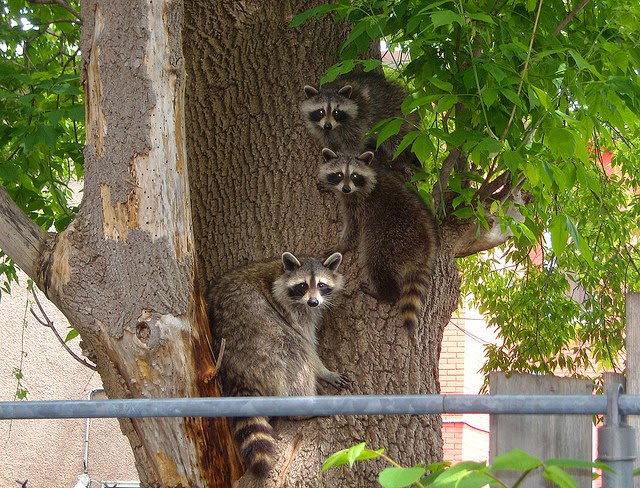 |
| Raccoon family |
the Ides of March, the soothsayer told Caesar, foretelling the day he would be
assassinated. In the Spring of 2015, the dire message should go to our local
wildlife.
the temperature warms, wildlife becomes more active and birthing season soon
follows. Humans start to go outdoors
more and the wildlife/people conflict begins to heat up too. The most obvious sign is the carnage on our roadways
that we begin to witness. The sign here
at the OHS is the influx of wild animals. Sadly, many of these creatures will
be juveniles that would have been safer had they been left where they were. There simply aren’t enough rehabilitation
spaces for all the wildlife in our region, and most didn’t need our help in the
first place.
know that stumbling upon a baby animal that appears to need help brings out a
helping instinct in all of us but spotting a baby animal by himself doesn’t necessarily
mean he’s an orphan. Many wildlife parents leave their young alone during the day,
sometimes for long periods. The mother is usually nearby and quite
conscious of her young. Also, keep in mind that despite their small size,
many young animals are actually independent enough to fend for themselves.
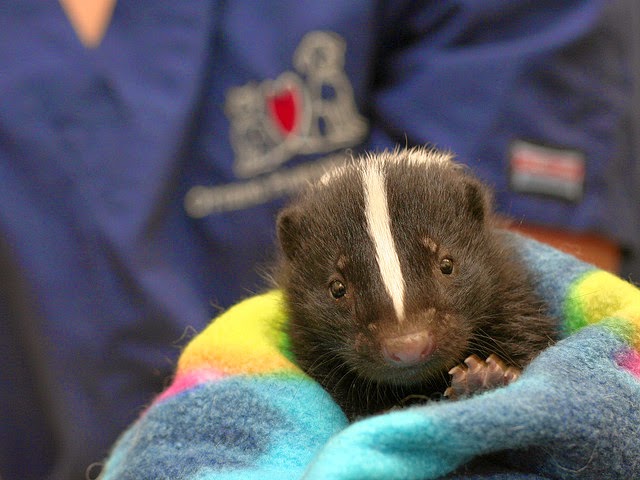 |
| Many wildlife parents leave their young alone during the day. |
help or should be left alone? If an animal needs your help, you will see one or
more of the following signs:
- A wild animal presented
to you by a cat or dog - Bleeding
- An apparent or obvious
broken limb - Evidence of a dead
parent nearby - Unusual or uneven loss
of fur - Difficult or raspy
breathing or sneezing - Body covered in fleas
there.
human wildlife conflicts, please visit https://ottawahumane.ca/protection/wildlifeissues.cfm
before you act.
Live Trapping and Relocation
Is NOT the answer to conflicts with wildlife
Live trapping may seem like an immediate and easy fix to your wildlife problem, however it is only a temporary solution. The homeowner should find out what attracted the animal to their property and remove and remove the sources of attraction. Otherwise, another animal will take up residence once the other animal has been removed, which can turn into a frustrating, reoccurring problem. Wildlife-proofing your home and property is a long-term, preventative and humane solution.
Why can’t I trap wildlife and move the animals to another area?
Many people think that live trapping is a humane option because it does not result in the animal’s immediate death. In reality, live trapping and relocation is inhumane, cruel and ill-advised for the following reasons:
- Live trapping causes great stress for the trapped animal, and they may seriously injure themselves as they desperately attempt to escape.
- The trapped animal is exposed to the elements and can suffer from painful cases of frostbite and heat stroke. If an animal is left in the trap, it will suffer for days and will eventually die of exposure or starvation.
- Domestic animals and other wildlife may harass the trapped animal causing further stress, injury or death.
- Trapped and relocated animals may be separated from their young, and the dependent young left behind will die an inhumane death.
- Relocated animals are at an extreme disadvantage in a new environment. They have to find food, water and shelter in an unfamiliar territory. There may be territorial disputes between the relocated animal and resident animals that can lead to injury and even death. Relocated animals may also spread disease to the resident wildlife population, therefore causing other animals to become ill or die.
- In Ontario, it is illegal to trap and relocate animals 1km from where they were captured according to the Ministry of Natural Resources’ Fish and Wildlife Conservation Act.
- Improper use of a live trap, which results in animal suffering, could lead to animal cruelty charges through the Ontario PAWS Act.
Although people’s initial reaction may be to get rid of wild animals, trapping will not solve the problem. As long as an inviting habitat exists, wild animals will use it.
The Ottawa Humane Society does not rent or sell humane traps for the purpose of trapping and relocating wild animals.
Source: Ontario Ministry of the Solicitor General, the Ottawa-Carleton Wildlife Centre and the Humane Society of the United States.
For more information on wildlife, contact the Ottawa Humane Society at 613-725-3166 ext. 223, or send us an email.

